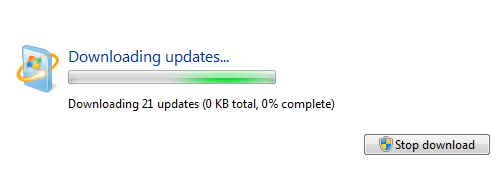The Windows Update feature, while an immensely important one, can be a source of pain sometimes. Users have complained that at times Windows Update simply stalls at 0% when downloading and refuses to budge forward.
Are you encountering this issue as well? The good news is that you can relax because in this we’ll show you five simple fixes to resolve this problem for once and for all.
Solution #1 – Run Troubleshooter
The good thing about Windows operating system is that it usually includes a troubleshooter, which can prove handy when in distress. You can use the inbuilt troubleshooter in Windows 7 to flick off this pesty error.
Here are the steps to follow:
- Click the Start menu. Next, type “troubleshoot” in the start search bar. Click Troubleshooting in the displayed results.
- Navigate to the System and Security section inside the Troubleshooting window, click Fix problems Windows Update
- Click the Next button in the Windows Update window
Solution #2 – Reset Windows Update Service
This is the built-in service that allows Windows users to use Windows Update. In case you encounter a problem with Windows Update, we recommend you can reset this service to check if that does the job.
Here are the steps to follow:
- Simultaneously press Windows key + R key on the keyboard. In the Run dialog box, type msc and then click the OK button
- In the Services window, browse through the list on your right to locate Windows Update Single-click on this service and then click Restart in left pane.
- Wait for the restart of Windows Update to complete
Solution #3 – Update Windows Update Agent
An inbuilt agent program, Windows Update Agent helps identify updates that your computer requires and then download them. Many users have reported they were able to fix Windows Updates not downloading issue by updating Windows Update Agent, so it’s definitely worth a try.
You first need to download and install the program and then update it. You can download it from Microsoft website.
Important: You need to have Service Pack 1 (SP1) installed on your Windows 7 computer before you can update Windows Agent. Refer to the Microsoft official guide for downloading and installing Windows 7 Service Pack 1.
Once you have Windows 7 SP1, perform the following steps:
- Go to Microsoft support website
- Click Stand-alone packages for Windows 7 SP1 and Windows Server 2008 R2 SP1. Now choose the installation package that is appropriate for your Windows operating system and then download it and save it to a suitable location on your computer
- Now open this file and follow onscreen instructions to complete installation
- Once the program has been installed, reboot Windows. Check if the problem is fixed
Solution #4 – Download Updates Manually
What if Windows Update isn’t able to download these Updates? What should you do then?
It is very much possible download updates manually and install them. This way you can keep your Windows 7 system up-to-date and fix the titled error.
Here are the steps to follow:
- Click the Start menu
- Type “update” in the start search bar
- Now click Windows Update in the displayed results
- Choose updates available. Windows will now show you a list of updates that are available for download
- Go through the list and check the update code (You should look for code starting with KB) of Windows updates you need to download
- Now head to Windows Download Center and look for the code you need
- In the search results, you may see multiple Downloads Click the result that you need to download
- Now click the Download button to start the downloading process and save the downloaded file in an appropriate location on your PC
- Once the download process is complete, open the file and follow the instructions on your screen to complete the installation process
This way you can install all important system updates one by one. For sure, installing multiple updates manually is likely to require a lot of time, but the tradeoff is that it can fix the titled error and ensure the smooth functioning of your Windows computer.
Solution #5 – Perform a clean boot
In case the problem persists in spite of completing the proposed solutions above, check if any particular is interfering with Windows Update.
You will need to perform a clean boot to do that. This basically means starting Windows with as few drivers and startup programs as possible. This way you can locate the application that is triggering the issue.
Here are the steps to follow:
- Simultaneously press Windows key and R key on your keyboard
- In the run dialog box, type msconfig and then press the OK button
- In the System Configuration box, click the General tab. The default setting here is Normal startup. What you need to do is choose Selective startup and unselect the checkbox in the front of Load startup items
- Now click the Service tab (third from left)
- Select the box in the front of Hide all Microsoft services. Now click Disable all (It is necessary that you first hide all Microsoft services and then click the Disable all button. Otherwise, you may disable some secure services, which in turn can trigger unexpected and severe consequences.)
- Click the OK button
- Reboot Windows. Now your system will boot into clean boot state. Once Windows has booted, check if you are able to download updates the normal way, that is, through Windows Update. In case you are, use the steps listed above to enable the services separately, that is, one by one. This will help you identify the application that is causing the problem. Once you have identified the application that’s at fault, you can either uninstall or disable it.
Important: Once you have finished troubleshooting, don’t forget to restore the original System Configuration settings.


Leave a Reply